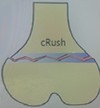Jordan's study guide- bone Flashcards
Periosteum
Membrane covering bone
Cortical
Hard outer bone
Trabecular
Spongy inner bone
What are these

Osteoblasts
What do osteoblasts do
Build bone
What are these

Osteocytes
What are these

Osteoclasts (break down)
What do osteoclasts do
Destroy bone
What type of bone is the top arrow pointing to

Laminar bone
What is the bottom arrow pointing to

Woven bone
Where does intramembranous ossification occur
Flat bones with no growth plates
Where does intramembranous ossification begin
Fibrous connective tissue membrane
What does intramembranous ossification form
Woven bone and periosteum
Final layer of compact bone
Where does endochondral ossification occur
Long bones
Requires growth plates
What does a growth plate need to function
Angiogenesis
Adequatly mineralize collagen/cartilage
Adequate supply of blood vessels
What are the 7 ways to describe a fracture
O: Open vs. closed
L: location
D: Degree (complete/incomplete)
A: articular extension
C: communication/pattern (multiple pieces)
I: Intrinsic bone quality
D: Displacement
4 steps to fracture healing
- Hematoma
- Fibrocartilaginous callus
- Bony callus
- remodeling
Salter type

1
Salter type

4
Salter type

3
Salter type

5
Salter type

2
Probem with osteoclasts
Failure of remodling
Increased bone density

Osteopetrosis
Bone resorption>formation
Disuse, malnutrition
Suseptible to fracture

Osteoporosis















